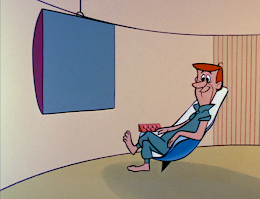 He claimed he wasn’t a writer, but Jack Benny said he was an excellent editor.
He claimed he wasn’t a writer, but Jack Benny said he was an excellent editor.
Read more here.
 No, I am not wishing George Jetson a happy birthday today.
No, I am not wishing George Jetson a happy birthday today.


 “Leave It To Beaver” had no clumsy dad, no precocious child stars. Even hardened critics talked about the pilot show’s warmth and sincerity.
“Leave It To Beaver” had no clumsy dad, no precocious child stars. Even hardened critics talked about the pilot show’s warmth and sincerity.
 Whether Walter Cronkite, Chet Huntley or David Brinkley liked it or not, or didn’t want to admit it, they became TV stars.
Whether Walter Cronkite, Chet Huntley or David Brinkley liked it or not, or didn’t want to admit it, they became TV stars.


 It’s remarkable that Jack Benny hit the five-year mark of his radio show and he didn’t even have two of the people which we all think of today when Benny comes to mind.
It’s remarkable that Jack Benny hit the five-year mark of his radio show and he didn’t even have two of the people which we all think of today when Benny comes to mind.



 He was more than just Ed Norton, and Art Carney set out to prove it after The Honeymooners went off the air in 1956.
He was more than just Ed Norton, and Art Carney set out to prove it after The Honeymooners went off the air in 1956.


 Stars, big and little, toured military camps during World War Two. One was Jack Benny. Jack went beyond all of what you’ve read.
Stars, big and little, toured military camps during World War Two. One was Jack Benny. Jack went beyond all of what you’ve read.



 People seem to love lists. They also seem to love bad movies. What happens when you put them together?
People seem to love lists. They also seem to love bad movies. What happens when you put them together?

 Don Wilson settled in for a long run as Jack Benny’s announcer in 1934, but there were a few shows when someone else filled in.
Don Wilson settled in for a long run as Jack Benny’s announcer in 1934, but there were a few shows when someone else filled in.
 Theatrical cartoon characters helped boost the Allied effort during World War Two. Let’s focus on a little slice of events of the era.
Theatrical cartoon characters helped boost the Allied effort during World War Two. Let’s focus on a little slice of events of the era.


 Depending on your age, Johnny Carson is still the King of Late Night Television.
Depending on your age, Johnny Carson is still the King of Late Night Television.

 Leon Schlesinger heeded the call of his country and of the Warner brothers, who decided in 1939 that patriotic films were needed, by rushing the Merrie Melodies short Old Glory through production.
Leon Schlesinger heeded the call of his country and of the Warner brothers, who decided in 1939 that patriotic films were needed, by rushing the Merrie Melodies short Old Glory through production.
 Bill Frawley was immortalised as Fred Mertz, thanks to “I Love Lucy” which, I imagine, has never been off television since 1951.
Bill Frawley was immortalised as Fred Mertz, thanks to “I Love Lucy” which, I imagine, has never been off television since 1951.
 Maybe the oddest character to populate the Jack Benny radio world was one that wasn’t human.
Maybe the oddest character to populate the Jack Benny radio world was one that wasn’t human.
 John Sutherland Productions released some pretty attractive and imaginative animation/partially-animated short films for industrial customers in the late 1940s and the 1950s.
John Sutherland Productions released some pretty attractive and imaginative animation/partially-animated short films for industrial customers in the late 1940s and the 1950s.
 At one time, humour on national Canadian TV boiled down to The King of Kensington and the occasional Wayne and Shuster special.
At one time, humour on national Canadian TV boiled down to The King of Kensington and the occasional Wayne and Shuster special.